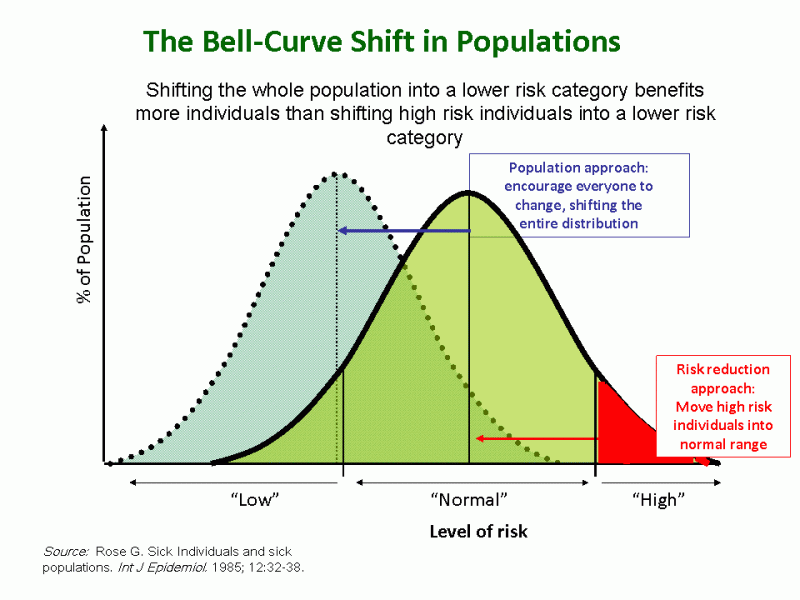Resources: The population approach to prevention
Despite the age of this quotation, we cannot do better than start by outlining the importance of a "population approach to prevention", well described in part of the World Health report in 2002, which summarises the population approach nicely - reproduced below:
"Population-wide strategies for prevention
"It makes little sense to expect individuals to behave differently from their peers; it is more appropriate to seek a general change in behavioural norms and in the circumstances which facilitate their adoption." -- Geoffrey Rose, 1992.
The distribution and determinants of risks in a population have major implications for strategies of prevention. Geoffrey Rose observed, like others before and since, that for the vast majority of diseases "nature presents us with a process or continuum, not a dichotomy". Risk typically increases across the spectrum of a risk factor. Use of dichotomous labels such as "hypertensive" and "normotensive" are therefore not a description of the natural order, but rather an operational convenience. Following this line of thought, it becomes obvious that the "deviant minority" (e.g. hypertensives) who are considered to be at high risk are only part of a risk continuum, rather than a distinct group. This leads to one of the most fundamental axioms in preventive medicine: "a large number of people exposed to a small risk may generate many more cases than a small number exposed to high risk". Rose pointed out that wherever this axiom applies, a preventive strategy focusing on high-risk individuals will deal only with the margin of the problem and will not have any impact on the large proportion of disease occurring in the large proportion of people who are at moderate risk. For example, people with slightly raised blood pressure suffer more cardiovascular events than the hypertensive minority. While a high-risk approach may appear more appropriate to the individuals and their physicians, it can only have a limited effect at a population level. It does not alter the underlying causes of illness, relies on having adequate power to predict future disease, and requires continued and expensive screening for new high-risk individuals.
In contrast, population-based strategies that seek to shift the whole distribution of risk factors have the potential to control population incidence. Such strategies aim to make healthy behaviours and reduced exposures into social norms and thus lower the risk in the entire population. The potential gains are extensive, but the challenges are great as well -- a preventive measure that brings large benefits to the community appears to offer little to each participating individual. This may adversely affect motivation of the population at large (known as the "prevention paradox").
Although most often applied to cardiovascular disease prevention, a population-wide approach is often relevant in other areas. For example, a high-risk strategy for melanoma prevention might seek to identify and target individuals with three or more risk factors (such as a number of moles, blonde or auburn hair, previous sunburn, and a family history of skin cancer). However, only 24% of cases of melanoma occur in this 9% of the population, so a targeted approach would succeed in identifying those at high risk but would do little for population levels of melanoma -- 75% of cases occur in the 58% of the population with at least one risk factor. A population-wide strategy would seek to make sun protection a social norm, so that the whole population is less exposed to risk.
These approaches are complementary: a population approach can work to improve and extend the coverage of a high-risk approach. A key challenge is finding the right balance between population-wide and high-risk approaches. Rose concluded that this will require a wider world view of ill-health, its causes and solutions, and will lead to acknowledgement that the primary determinants of disease are mainly economic and social, and therefore remedies must also be economic and social."
The picture below demonstrates the theoretical difference between the population and the high risk approaches to prevention.

